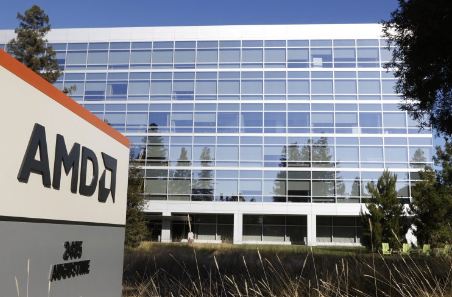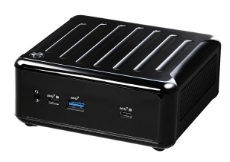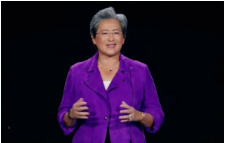AMD Takes Center Stage at CES
AMD President and CEO Lisa Su took to the stage at CES to give what some analysts suggested was the most important appearance by AMD at a tradeshow since a keynote at the now-defunct Comdex by then-CEO Hector Ruiz in 2002. She did not disappoint.
Su announced that the Radeon VII GPU would be available starting next month and that its second-generation Ryzen mobile processors would begin showing up in ultrathin and gaming laptops by the end of the first quarter. Su also teased AMD's third-generation Ryzen desktop processor and its second-generation EPYC server processor, both of which are implemented in 7nm and will be available starting later this year.
Analysts were enthusiastic about the announcements made by Su Wednesday in the first CES keynote by AMD since 2009, though at least some of the news had been revealed previously. Last November at an event in San Francisco, AMD first announced the 7nm Radeon 7 GPU and the 7nm server processor, which is codenamed "Rome" and based on AMD's Zen 2 x86 microarchitecture. The second-generation Ryzen mobile processors were announced by AMD on Sunday, prior to the start of CES.
But Su provided more details Wednesday on all three chips.
"I think this was a landmark event for AMD," said Kevin Krewell, a principal analyst at Tirias Research. "It was quite dramatic for AMD to usurp the leadership role from Intel."
Indeed, with 7nm silicon available next month, AMD will beat both Intel and Nvidia to the most advanced technology node. And by returning to the CES keynote stage, AMD also upstaged its rival, which lost its most coveted CES keynote spot this year to LG Electronics. (Intel, which has yet to replace CEO Brian Krzanich after he abruptly resigned in June, instead held a press conference event Monday).

AMD President and CEO Lisa Su shows a 7nm Radeon VII graphics card. (Source: CES)
Radeon VII, built on AMD's second-generation Vega architecture, boasts twice the memory and memory bandwidth compared to AMD's current top-of-the-line Radeon. It also improves gaming performance by up to 29% and offers up to 36% better content creation performance compared to the incumbent, AMD said.
The device features 60 compute units (or 3,840 stream processors) running at up to 1.8GHz. It also has 16GB of HBM2 memory and 1 TB/s memory bandwidth.
"We really believe at the high end enthusiast market, you need great hardware," said Su, who devoted most of her 90-minute keynote to the gaming sector.
She stressed that gaming requires cutting edge technology and brings people closer together. "Gamers love great technology and they provide us great feedback," Su said.
The second-generation mobile Ryzen processors, AMD's Ryzen 3000 Series, are designed for both ultrathin and gaming laptops. The initial 3000 Series chips feature two or four cores with eight or four threads and boost performance of up to 4.0GHz. They will be available in laptops starting later in the first quarter and throughout the rest of the year from the likes of Acer, ASUS, Dell, HP, Huawei, Lenovo and Samsung.
Perhaps most notable about the Ryzen 3000 Series is that the devices enable up to 12 hours of general productivity and 10 hours of video playback battery life, according to AMD.
"If it can actually provide 12 hours of 'productivity battery life" — not fake MobileMark or video playback — this would be big," Moorhead said. "It would be longer than any other notebook. I am looking forward to the reviews and testing myself."
Details on the third-generation Ryzen desktop processors remain sketchy. Su showed an early version of the 7nm device going head-to-head with a top-of-the-line Intel Core i9 processor. The third-generation Ryzen desktop processors are based on AMD's Zen 2 microarchitecture and are expected to be the first PC processors to support PCIe 4.0 connectivity. Su said they would be introduced in mid-2019.
"As a desktop processor, it will absolutely set the bar" in performance, features, and power efficiency, Su said.
Su also showed the Rome 7nm datacenter CPU, which is also based on the Zen 2 microarchitecture. She showed a demonstration pitting a pre-production EPYC Rome processor against two high-end Intel Xeon Platinum 8180 processors, with the EPYC processor showing about 15% greater performance.
Among other things, Su said the second-generation EPYC offers four times the floating point performance and twice the computing performance per socket compared to its predecessor. "I will go so far as to say we believe it is the best server processor the world has ever seen," Su said.
"AMD has achieved phenomenal performance with Zen 2, something that we haven't seen in the x86 architecture for the past decade," said Jim McGregor, principal analyst at Tirias Research. "We finally have competition in PCs and servers from top to bottom. This bodes well for the future in products from both AMD and Intel."
Speaking generally about the importance of high-performance computing at the beginning of the keynote, Su said the dramatic increases in the number of connected devices and data generated by them demand dramatic innovation to keep pace, particularly with Moore's Law scaling slowing to a comparative crawl.
"We are absolutely determined to drive high-performance computing innovation at the bleeding edge," Su said. "This is our job one."
在线留言询价
- 一周热料
- 紧缺物料秒杀
| 型号 | 品牌 | 询价 |
|---|---|---|
| MC33074DR2G | onsemi | |
| CDZVT2R20B | ROHM Semiconductor | |
| RB751G-40T2R | ROHM Semiconductor | |
| BD71847AMWV-E2 | ROHM Semiconductor | |
| TL431ACLPR | Texas Instruments |
| 型号 | 品牌 | 抢购 |
|---|---|---|
| STM32F429IGT6 | STMicroelectronics | |
| BU33JA2MNVX-CTL | ROHM Semiconductor | |
| TPS63050YFFR | Texas Instruments | |
| IPZ40N04S5L4R8ATMA1 | Infineon Technologies | |
| ESR03EZPJ151 | ROHM Semiconductor | |
| BP3621 | ROHM Semiconductor |
- 周排行榜
- 月排行榜
AMEYA360公众号二维码
识别二维码,即可关注




























